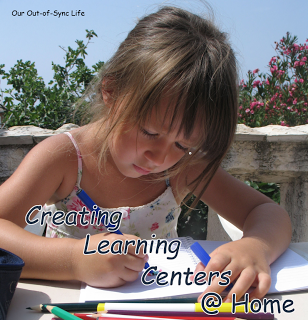 |
| source |
Preschool, churches, and schools are now using
stations to help children with independent and persistent play as well
as interactive learning. But stations are now being used in homes. (If you have missed our series on teaching your child independent play, please click to read the beginning post.)
Here is a description of learning stations that I found on the internet.
Learning
Stations are separate areas set aside in the classroom specifically
designed for small group interactive learning. Each station is equipped
with teacher developed learning materials and activities which are
designed to teach or reinforce a specific skill or concept. The teacher
designed materials and activities can be of various formats, including,
but not limited to, work mats, games, manipulatives, and/or worksheets. 1
In summary, a learning station is an area set aside for learning to occur around one material or activity. Even more basic, a learning station is an specific place where a specific activity will be done.
Think of a train as it pulls into stations along its route. Each station has a specific characteristic or distinguishing attribute about it.
Types of Stations
In our preschool-age “Sunday School”
classrooms at church, the children walk into a room with puzzle,
coloring, trains, kitchen, and book stations. Sweet Pea’s Kindergarten
classroom had name station, lacing, reading, writing, play dough, and water stations, to name a few. While I don’t call them stations, we have train, car, Legos, craft, paint, book, and block as well as other stations in our home. All stations are provided to provide the child with a learning activity.
Most stations come and go as need be while others stay permanently (like reading stations). I find it easiest to store station supplies together in the toy closet. Makes it super easy to pull out and put away.
Areas Set for Stations
While a school classroom may keep one area of a room specific to a learning station, in our home stations move around as needed depending on the activity. A play dough station by be set up at the kitchen table or on the back porch (so much easier to clean up!). A book station could be on a couch, bed, or in a reading corner. A tent makes a fun reading station as well. A name station could be at the refrigerator with magnetic letters or at an easel. One station could be a teaching station where the child learns a new concept with mommy.
When introducing the child to a station be sure to explain the boundaries to an area. Physical boundaries are easier for the child to understand than abstract. For example, a rug lays out an exact area for the child to stay. An drawing on an easel shows the child exactly where she is to draw. If the child is to play with trains only in the living room, make sure this is stated at the beginning or you may have train tracks running under the dining room table.
Also make sure the child understands your expectations for station time. May the child get a drink? May the child use the bathroom or should he wait until station time is over?
Using Stations
Stations are especially great when you have more than one child (that’s why they work so great in a school or church setting). Let me give you an example from our summer school time.
Peanut is sitting on a rug playing with a Legos. Sweet Pea is writing in her journal at the table. Little Man is working on coloring at the desk while Bubs is reading with Mommy in the beanbags. After several minutes, the kids will rotate to a new station. Peanut will draw in his journal at the table, Sweet Pea will work at the desk on drawing, Little Man will read with Mommy and Bubs will build math sentences with Legos. Notice that the stations were similar but tailored to the child’s needs.
What’s the Point?
Honestly, I don’t think in “stations” because that word came after my training. And Moms have been creating “learning stations” before trains were invented. The concept is far from new. But the no matter what you call it, the technique can be added to any home to help children stay with one activity for a specific length of time, develop independent play, improve imagination, and insure learning.
![]()
How do you incorporate learning stations into your home?
